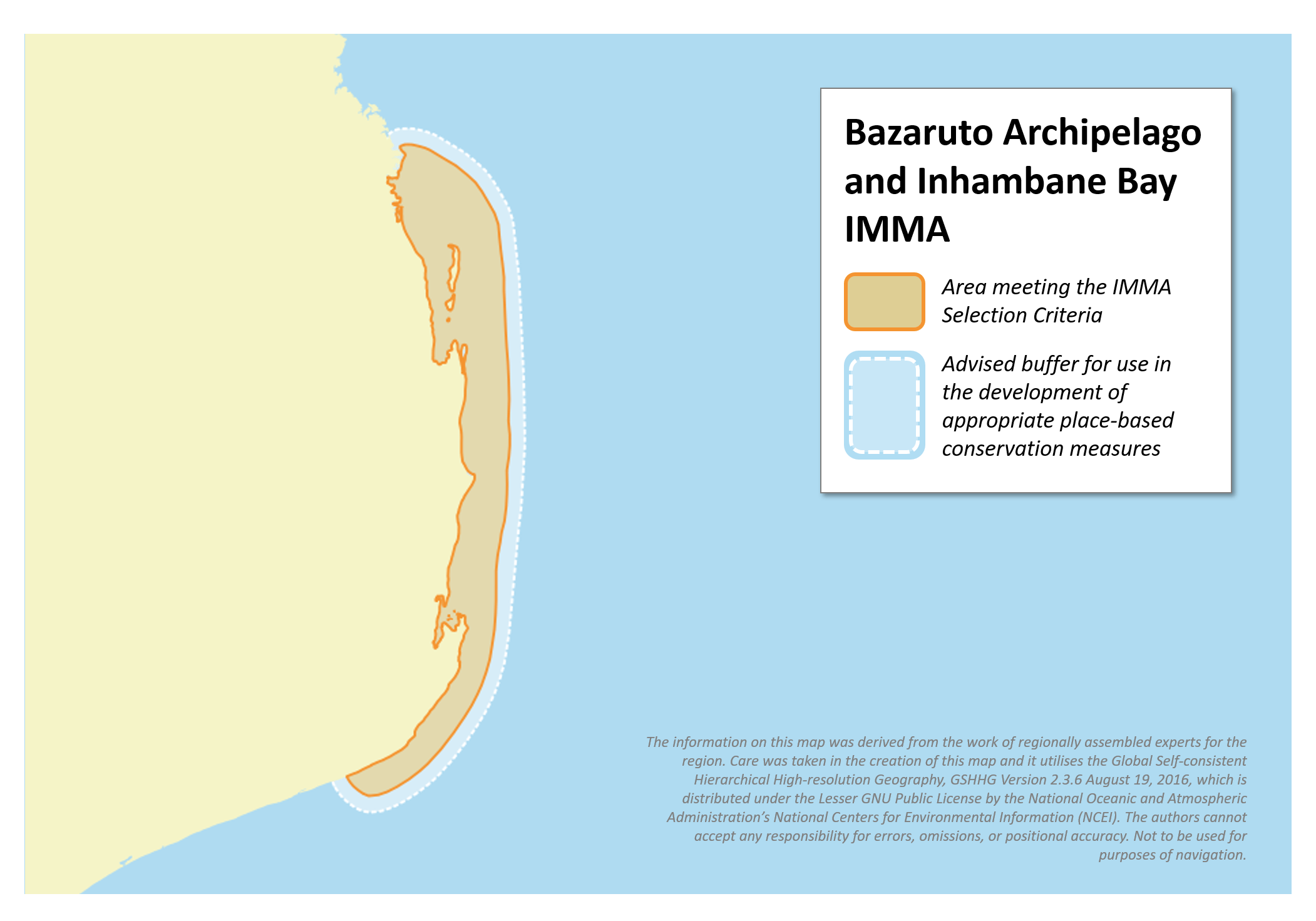Bazaruto Archipelago and Inhambane Bay IMMA
Size in Square Kilometres
16 280 km2
Qualifying Species and Criteria
Dugong – Dugong dugon
Criterion A; B (1)
Marine Mammal Diversity
Sousa plumbea, Orcinus orca, Stenella longirostris, Stenella attenuata, Delphinus delphis, Feresa attenuata, Lagenodelphis hosei, Megaptera novaeangliae, Balaenoptera acutorostrata, Pseudorca crassidens, Tursiops aduncus
Download fact sheet
Summary
The Bazaruto Archipelago and Inhambane Bay are on the East coast of Central Mozambique, extending from the Save River in the north to Tofino in the south. Both bays have extensive shallow waters, with large tidal ranges and extensive seagrass beds. Vessel-based, aerial and questionnaire surveys conducted from 1991-1997, followed by aerial surveys between 2007 and 2018 suggest that the Bazaruto Archipelago supports the last viable population of dugongs (Dugong dugon) in the Western Indian Ocean. With other populations in the East African region close to extirpation, the estimated population of between 250 and 350 individuals represents the species’ last stronghold in the region.
Description of Qualifying Criteria
Criterion A – Species or Population Vulnerability
Dugong dugon (Muller, 1776) has been assessed as a Vulnerable species by IUCN Red List since 1982. The results of the past three decades of research in the Western Indian Ocean led to a comprehensive research project on the numbers and distribution of dugongs along the East African coast (Cockcroft et al., 2018). Dugong ‘hotspots’ in Kenya, Tanzania and Mozambique were identified through historical knowledge, fisher questionnaires and satellite telemetry. At ‘hotspots’ further questionnaire and focal group surveys were undertaken, including unpublished aerial surveys between 2007 and 2018. Overall the results for this research indicate that dugongs are all but extirpated from the East African region, other than in the Bazaruto Archipelago area (Findlay et al., 2011).
Criterion B: Distribution and Abundance
Sub-criterion B1: Small and Resident Populations
Both bays have extensive seagrass beds, and Inhambane Bay was known in the past to host substantial numbers of dugongs, though few, if any, remain. The Bazaruto dugong population, estimated at between 250 and 350 individuals, is the only known fairly large dugong population within the Western Indian Ocean. Population viability modelling suggests this population is viable, given zero mortality through anthropogenic causes, particularly incidental catch and disturbance through oil and gas exploration (Cockcroft et al., 2010). A management plan and conservation strategy for dugongs in the Bazaruto Archipelago has been formulated and submitted to the relevant authority Cockcroft et al., 2018). In addition, Cockcroft et al., (2018) have proposed that Mozambique’s dugongs be regarded as an IUCN special management unit and classed as highly endangered. Consequently, this is believed to be the last and only viable dugong population left off East Africa (Cockcroft, et al., 2018).
Supporting Information
Cockcroft VG. 1995. Aerial survey in Kenya finds few dugongs. Sirenews 24 [newsletter of the IUCN/SSC Sirenian Specialist Group].
Cockcroft VG, Salm RV, Dutton TP. 1994. The status of dugongs in the western Indian Ocean. In: First International Manatee and Dugong Research Conference, 11–13 March 1994, Gainesville, Florida.
Cockcroft VC, Young DD. 1998. An investigation of the status of coastal marine resources along the west coast of Madagascar. Unpublished report, Worldwide Fund for Nature (WWF), Gland, Switzerland.
Cockcroft, V.G., Findlay, K.P. Guissamuo, A.T., Lindsay West, Mohamed, M. 2018. Dugongs (Dugong dugon) of the Western Indian Ocean Region: – Identity, Distribution, Status, Threats and Management. Western Indian Ocean Science Association Final Technical Report.143pp.
Findlay, K.P., Cockcroft, V.G., and AT Guissamulo. 2011. Dugong abundance and distribution in the Bazaruto Archipelago, Mozambique. African Journal of Marine Science 2011, 33(3): 441-452
Kizka, J and C. Muir. 2008. Status of the marginal dugong (f) population in the lagoon of Mayotte (Mozambiqur Channel) in the Western Indian Ocean. Western Indian Ocean Journal of Marine Science, 6(1), 111-116.
Komora, A. 1996. Life in the Wild: Last chance for Kenya’s mermaids. Swara 19 (5): 13-13.
Marsh H, Penrose H, Eros C, Hugues J. 2002. Dugong status reports and actions plans for countries and territories. Nairobi: UNEP.
Muir CE, Sallema A, Abdallah O, De Luca DW, Davenport TRB. 2003. The dugong (Dugong dugon) in Tanzania: a national assessment of status, distribution and threat. Wildlife Conservation Society.
Wamukoya, G.M., Mirangi, J.M. and W.K. Ottichilo. 1995. Marine Aerial Survey (Sea Turtles and Marine Mammals). KWS Technical Series Report No. 1.
https://www.dugongs.org/
https://www.wiomsa.org/ongoing-project/dugongs-dugong-dugon-of-the-western-indian-ocean-region-identity-distribution-status-threats-and-management/
http://www.dugongconservation.org/project/developing-education-awareness-campaign-conserve-dugongs-bazaruto-archipelago-mozambique-mz3/
http://www.dugongconservation.org/project/distribution-dugongs-coastal-waters-mozambique-mz2/


